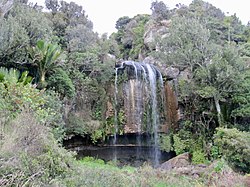|
Waikaretu
 Waikaretu (Māori: Waikāretu) is a rural community and caving area in the Waikato District and Waikato region of New Zealand's North Island. It is located 49 kilometres south-west of Tuakau.[3] A local farmstay also provides guided horse treks.[4] Waikāretu translates as "waters of the kāretu grass"; wai means water; and kāretu is a sweet-scented grass.[5] History20th centuryThe current Waikaretu settlement was established with the opening of a local school in 1924.[6] The Waikaretu War Memorial Hall was built in 1952. It has no Roll of Honour, but includes a plaque commemorating those who served in both World War I and World War II.[7] 21st centuryBy the 2010s the area featured several dairy farms, including the third-generation Whitford farm.[8] In 2016, the Overseas Investment Office granted a Chinese company, Weihai Station, approval to buy 595 hectares of coastal land.[9] Part of the land will be used for a lodge and training facility, with the rest continuing to operate as a sheep and beef farm.[10] The company gave Waikaretu School $25,000 in grants between 2016 and 2020.[11] Also in 2016, a secretive group began tunneling into the side of road searching for the skeletons of a mythical race of pre-Polynesian giants.[12] They called off the search in February 2020, after iwi, academics and the landowner raised concerns about the dig.[13] Nikau Cave The area features the 1 kilometre (0.62 mi) long Nikau Cave, which has limestone pillars, stalactites and stalagmites.[3] The caves contain many thousands of glow-worms which visitors can observe up close.[14] Ninety minute guided adventure tours are available, which are often wet and muddy.[15] There is a visitor cafe, and there are several accommodation options nearby.[16] A British analysis of TripAdvisor reviews in 2020 identified the cave as one of New Zealand's best secret tourist spots.[17][18] Philip and Anne Woodward moved to the area in 1978,[14] purchasing a 204 hectare sheep and dairy farm that included Nikau Cave. They opened the cave to the public in 1994, after their farming lease on a neighbouring 242 hectare block ended and they could no longer make enough money from farming and shearing services.[18][19] The cave has been formed in Waimai Limestone,[14] which is about 28m years old, hard, flaggy, glauconitic, pebbly[20] and over 90% formed of calcium carbonate.[21] There is also a path beside Waikaretu Stream, through QEII protected areas of bush, from near the cave to the foot of a waterfall.[22] DemographicsWaikaretu is in an SA1 statistical area which covers 133.47 km2 (51.53 sq mi).[1] The SA1 area is part of the larger Port Waikato-Waikaretu statistical area.[23]
Waikaretu had a population of 141 at the 2018 New Zealand census, an increase of 12 people (9.3%) since the 2013 census, and an increase of 30 people (27.0%) since the 2006 census. There were 51 households, comprising 69 males and 72 females, giving a sex ratio of 0.96 males per female. The median age was 35.6 years (compared with 37.4 years nationally), with 33 people (23.4%) aged under 15 years, 24 (17.0%) aged 15 to 29, 75 (53.2%) aged 30 to 64, and 9 (6.4%) aged 65 or older. Ethnicities were 57.4% European/Pākehā, 48.9% Māori, 2.1% Pacific peoples, 2.1% Asian, and 2.1% other ethnicities. People may identify with more than one ethnicity. Although some people chose not to answer the census's question about religious affiliation, 66.0% had no religion, 25.5% were Christian, 2.1% had Māori religious beliefs and 2.1% had other religions. Of those at least 15 years old, 12 (11.1%) people had a bachelor's or higher degree, and 33 (30.6%) people had no formal qualifications. The median income was $32,600, compared with $31,800 nationally. 12 people (11.1%) earned over $70,000 compared to 17.2% nationally. The employment status of those at least 15 was that 63 (58.3%) people were employed full-time, 12 (11.1%) were part-time, and 6 (5.6%) were unemployed.[2] EducationWaikaretu School is a co-educational state primary school for Year 1 to 8 students,[24][25] with a roll of 25 as of November 2024.[26] See alsoReferences
External links
|
|||||||||||||||||||||||||||||||||||||||||||||||||||||

